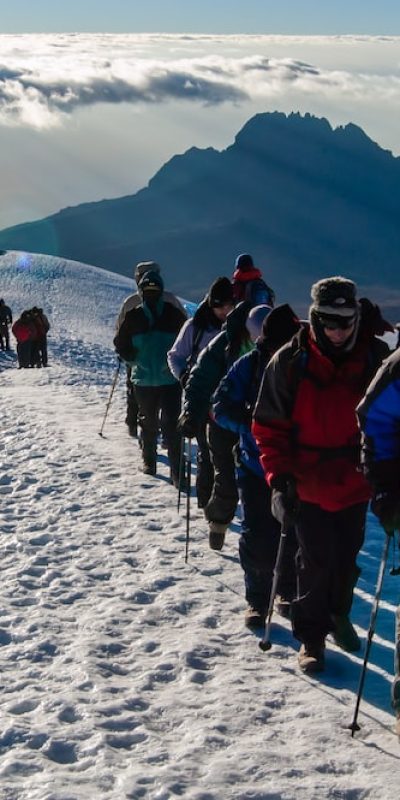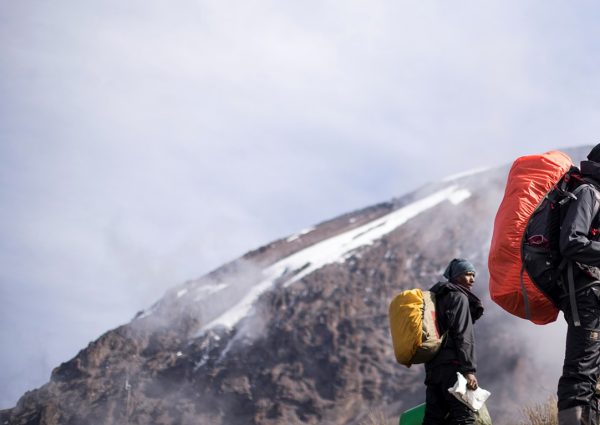
About Kilimanjaro
Mount Kilimanjaro is composed of three distinct volcanic cones: Kibo 19,340 feet (5895 meters); Mawenzi 16,896 feet (5149 m); and Shira 13,000 feet (3962 m). Uhuru Peak is the highest summit on Kibo’s crater rim.
Mount Kilimanjaro is a giant stratovolcano that began forming a million years ago, when lava spilled from the Rift Valley zone. Two of its three peaks, Mawenzi and Shira, are extinct while Kibo (the highest peak) is dormant and could erupt again.
The last major eruption has been dated to 360,000 years ago, while the most recent activity was recorded just 200 years ago. Kilimanjaro has 2.2 square kilometres (0.85 sq mi) of glacial ice and is losing it quickly due to climate change. The glaciers have shrunk 82% since 1912 and declined 33% since 1989. It might be ice free within 20 years, dramatically affecting local drinking water and crop irrigation.
Who Can Climb Kilimanjaro?
Anyone from children over the age of 10 to older generations in their 60s and 70s! All you need is determination and the will to get to the summit. The real challenge with climbing Kilimanjaro is the altitude and the rate of ascent. Don’t worry we will be with you every step of the way! Our guides are highly skilled professionals and are a key component to your success.
Join the thousands of climbers who have stood on the Mount Kilimanjaro Summit Guided by Our Expert Team
Kilimanjaro climb guide company:
We are a premier Kilimanjaro trekking Tours company with decades of combined experience on the mountain, we specialize in climbing Mount Kilimanjaro. We run our own trekking operations, staffed with expert mountain guides, and do not act as a booking agent for other companies. We will give you comprehensive advice on packing, fitness, expected weather and trail conditions, and be by your side every step of the way – all the way to the Summit of Kilimanjaro! We will also bring you to the airport after the adventure of a lifetime.
Hiking Kilimanjaro Routes:
There are Seven main Mount Kilimanjaro routes which lead to the summit, Uhuru Peak, one of which starts on the Northern side of the mountain and the rest on the Southern side. The routes are Marangu, Machame, Lemosho, Shira, Rongai, Northern Circuit and Umbwe. Hiking Mount Kilimanjaro takes between five to nine days in order to reach the Summit and then descend to the finishing point. The more days spent on the mountain the more likely you will summit successfully because you will become more acclimated to the altitude.
Climbing Mount Kilimanjaro: Quick and Helpful Tips
Climbing Mount Kilimanjaro is an adventure, but requires preparation. Before Kilimanjaro hike we advise advice clients to do research and get themselves prepared so as they have a good experience in the end. You want to choose the right trekking company that will assist you every step of the way and get you ready for your big adventure of a lifetime! Below we have answered the questions you that might be thinking while getting ready
Here are some key points about altitude sickness and acclimatization on Kilimanjaro:
Altitude sickness, also known as acute mountain sickness (AMS), occurs when the body doesn’t get enough oxygen at higher altitudes.Common symptoms of AMS include headache, nausea, vomiting, fatigue, dizziness, and difficulty sleeping.If symptoms are severe or worsening, it can lead to more serious forms of altitude sickness, such as high-altitude cerebral edema (HACE) or high-altitude pulmonary edema (HAPE), which are potentially life-threatening and require immediate descent.
A key strategy for preventing altitude sickness is to climb gradually and allow your body time to acclimatize to the decreasing oxygen levels.
Kilimanjaro routes are designed to provide sufficient time for acclimatization. Most routes take several days to ascend, allowing climbers to adapt to the altitude.
Staying well-hydrated is crucial at higher altitudes. Drink plenty of water throughout the climb to prevent dehydration, which can exacerbate altitude sickness.
Eating small, nutritious meals can help maintain energy levels and support acclimatization.
Some climbers take medications like acetazolamide (Diamox) to help prevent altitude sickness. Consult with a healthcare professional before using any medications and follow their guidance.
Pay close attention to your body and communicate openly with your guides. If you experience symptoms of altitude sickness, inform your guide immediately.
Dress appropriately for the conditions and be prepared for cold temperatures at higher elevations. Proper gear can help you stay comfortable and reduce the risk of cold-related illnesses.
Many Kilimanjaro routes include acclimatization days where you hike to higher elevations during the day and then return to a lower camp for the night. This helps your body adapt to higher altitudes.
Some routes on Kilimanjaro are longer and provide more gradual acclimatization, such as the Machame and Lemosho routes. Consider choosing a route that suits your level of experience and preference for acclimatization.
Altitude sickness can affect anyone, regardless of age or fitness level, so it’s essential to be prepared and take it seriously. Climbing with an experienced and knowledgeable guide is strongly recommended, as they can monitor your condition and make informed decisions about your safety. If symptoms of altitude sickness become severe or do not improve with rest and descent, it’s important to descend to lower altitudes as quickly as possible to receive proper medical attention.

Altitude Sickness & Acclimatization
Altitude sickness is a concern when climbing Mount Kilimanjaro due to the significant altitude gain over a relatively short period. Kilimanjaro is the highest free-standing mountain in the world, with its highest peak, Uhuru Peak, standing at 5,895 meters (19,341 feet) above sea level. Altitude sickness can affect climbers at elevations above 2,500 meters (8,200 feet), and it’s important to understand how to prevent and manage it.
Frequently Asked Questions
Climbing Mt. Kilimanjaro is a major undertaking and if it seems too cheap, then you can be sure compromises are being made in terms of your safety, comfort, equipment and staff salaries. The cost of climbing Mount Kilimanjaro in Tanzania can vary widely depending on several factors, including the route you choose, the duration of the trek, the level of service and support you desire, and the time of year you plan to climb.
The best time to climb Mount Kilimanjaro in Tanzania largely depends on your preferences and priorities, as each season has its advantages and disadvantages. Kilimanjaro can be climbed year-round, but there are two primary climbing seasons to consider:
This is generally considered the best time to climb Kilimanjaro.Weather conditions are typically dry, with minimal rainfall, making for clearer skies and excellent visibility.The trails are less muddy, and the risk of encountering rain and snow is lower.The temperatures are more moderate, with warmer days and cooler nights at higher altitudes.This period is the peak climbing season, so it can be more crowded, and accommodations may fill up quickly.
This shoulder season offers a balance between fewer climbers and acceptable weather conditions.The landscapes are lush and green due to recent rains.The temperatures are still relatively mild, but there is a slightly higher chance of rain.It’s a good choice if you prefer a quieter trek and don’t mind the possibility of occasional showers.
